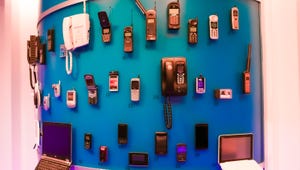
Inside Qualcomm HQ's Appointment-Only Museum Filled With Retro Phones - CNET
The Qualcomm Museum entrance
Qualcomm’s headquarters in San Diego, California includes a museum that documents the history of the company alongside the evolution of the telecommunications industry.

Qualcomm Museum
The museum requires an appointment to visit and showcases the company’s technological developments that include some of the first mobile devices that supported texting and GPS.

Omnitracs
Qualcomm’s first commercial product is the Omnitracs system launched in 1988, a satellite-based technology used in the trucking industry. It was a two-part system that allowed drivers to text and use GPS over satellite, as an alternative to using two-way radios that worked in remote areas.
The revenue from the Omnitracs product funded efforts that led to Qualcomm’s development of the CDMA platform. Qualcomm later sold Omnitracs in 2013.

Omnitracs for the military
In addition to the trucking industry, an Omnitracs system was also developed for the military. This particular model was approved by the National Security Agency and included two phone numbers, one for secure calls and another for nonsecure ones.

CDMA testing
Qualcomm moved into the development of the CDMA mobile technology, which at the time was being developed as a competitor to the similar TDMA technology. Its early benefits including more capacity and the ability to hand off phone calls from tower to tower. PacTel Cellular (which later becomes part of Verizon Wireless) was among the early adopters of CDMA.
CDMA networks were only recently phased out, with Verizon Wireless turning its 3G CDMA networks off at the end of 2022.

CDMA pay phone
Qualcomm developed a series of wireless payphones in 1998 that used CDMA technology to allow for calls in remote areas.

CDMA PC card
Among the CDMA devices on display is a Verizon Wireless PC card that allowed for laptops to use 3G networks in 2004.

CDMA test van
A van for testing CDMA technology.

Mobile Station Modem
Qualcomm’s Mobile Station Modem from 1992.

Mobile broadband technology
The larger device seen here was the first prototype high data rate modem used for the development and testing of what later became the EVDO standard. Qualcomm began demonstrating the technology in 1998, and the first commercial device using EVDO was released in 2004.
EVDO was an evolution of the CDMA standard, and was retired in 2022 as part of Verizon’s 3G network.

Beer for the first lab call
Several early satellite communication devices on display alongside a beer used to toast a first lab call.

Mobile device wall
The Qualcomm features this wall of phones, laptops, eReaders and other devices that all include technology developed by the company in some manner.

Mobile device wall
Another angle of the mobile device wall. The Kindle’s (in white, seen lower on the wall) connection is that data for it was held on Qualcomm’s servers.

Flip phones, PDAs
Several of the exhibits on display include popular devices from the early 2000s, including flip phones and personal digital assistants. The phone labeled no. 19 is the first camera phone, which used an external camera attachment to take photos.

Presidential phone
This phone was an example of what was used as part of the presidential limousine. This was a satellite phone that’s highly encrypted.

Car dashboard
Qualcomm’s museum also rotates in a variety of modern devices, and in this exhibit is an example of a car dashboard powered by Qualcomm. This idea of having the entire car dashboard represented by digital displays has become more common, with Apple revealing its large automobile interface at WWDC 2023.

Qualcomm chip
Qualcomm put its Snapdragon 8 Gen 2 chip on display for our visit, which is a very tiny piece of silicon that powers the most premium Android phones.

Test phone for Snapdragon
Qualcomm’s engineers use test phones like these while developing the company’s processors. These phones look and function much like a commercial device, but help with testing new features.

Surface Pro
Certain models of the Microsoft Surface Pro series include a Qualcomm Snapdragon processor as part of the computer’s build.

Motorcycle
This is a motorocycle engineering sample, which uses Qualcomm technology to power its automobile systems.

Motorcycle dashboard
This includes an information dashboard, with similar features to the wider one shown for automobiles.

Smart glasses, VR headsets, watches
Qualcomm also put other wearable devices on display that incorporate the company’s technology.

Qualcomm Museum tour
The Qualcomm Museum is open to visitors on weekdays, but only through a Qualcomm sponsor. More information on the museum is on the company’s website.

